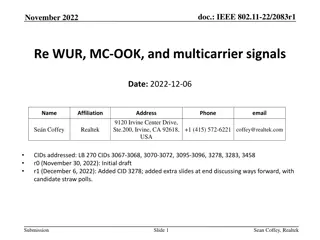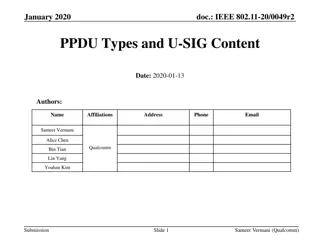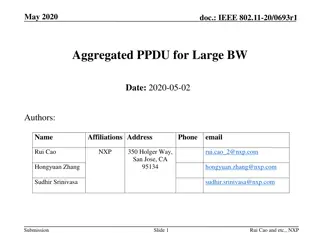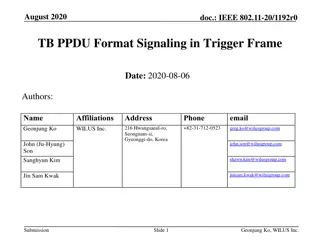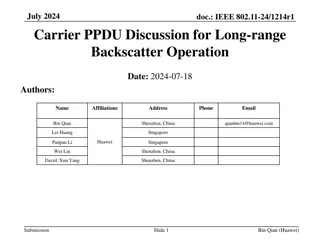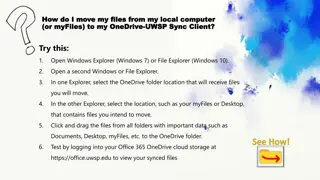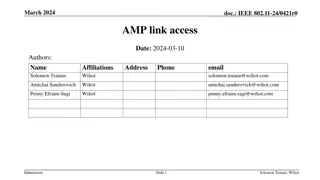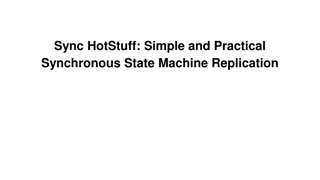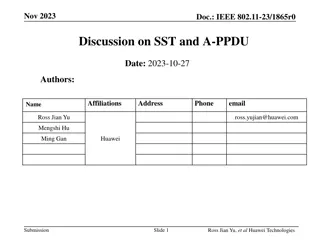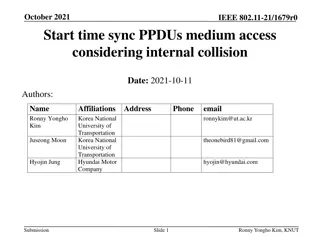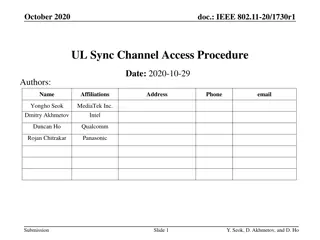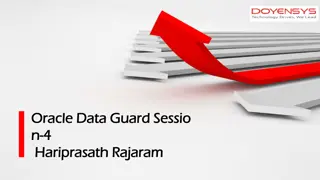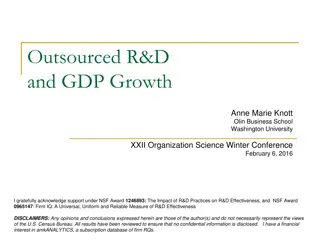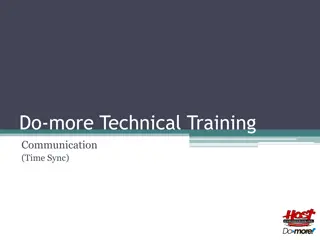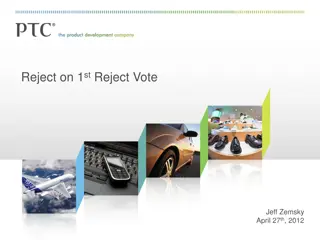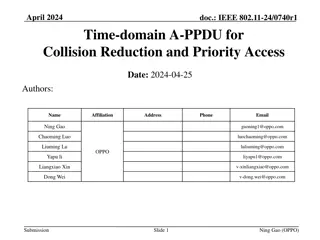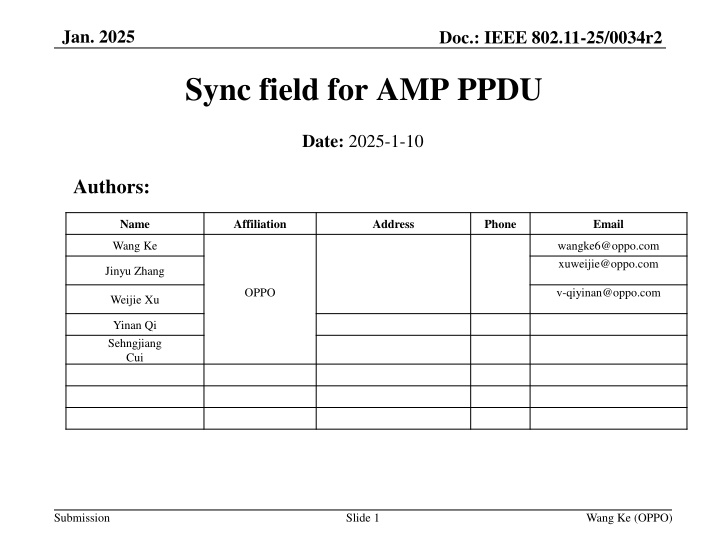
Proposed Methodology for IEEE 802.11-25/0034r2 Sync Field Design
Discover the high-level requirements and proposed methodology for AMP sync field design in IEEE 802.11-25/0034r2. Explore unique sync sequences, auto-correlation metrics, and considerations for different receiver types to ensure efficient synchronization in wireless communication.
Uploaded on | 2 Views
Download Presentation

Please find below an Image/Link to download the presentation.
The content on the website is provided AS IS for your information and personal use only. It may not be sold, licensed, or shared on other websites without obtaining consent from the author. If you encounter any issues during the download, it is possible that the publisher has removed the file from their server.
You are allowed to download the files provided on this website for personal or commercial use, subject to the condition that they are used lawfully. All files are the property of their respective owners.
The content on the website is provided AS IS for your information and personal use only. It may not be sold, licensed, or shared on other websites without obtaining consent from the author.
E N D
Presentation Transcript
Jan. 2025 Doc.: IEEE 802.11-25/0034r2 Sync field for AMP PPDU Date: 2025-1-10 Authors: Name Affiliation Address Phone Email Wang Ke wangke6@oppo.com xuweijie@oppo.com Jinyu Zhang OPPO v-qiyinan@oppo.com Weijie Xu Yinan Qi Sehngjiang Cui Submission Slide 1 Wang Ke (OPPO)
Doc.: IEEE 802.11-25/0034r2 Jan. 2025 Abstract In this contribution, we will firstly discuss the requirement for the Sync field and then propose candidate sync sequence. Submission Slide 2 Wang Ke (OPPO)
Doc.: IEEE 802.11-25/0034r2 Jan. 2025 High-level requirements for AMP sync(1) In [1]. the following requirements for AMP sync are discussed. Different sync sequences for DL/UL for indication. Support two different AMP DL rate e.g. 1Mbps and 250kbps using 2 different sync A correlator can distinguish between Sync length 16 and 32. The Sync sequence has the same number of 1 and 0. Good auto-correlation The sequence have 3 consecutive 1/0, which can help distinguish synchronization field and data field with Manchester coding. Submission Slide 3 Wang Ke (OPPO)
Doc.: IEEE 802.11-25/0034r2 Jan. 2025 High-level requirements for AMP sync(2) During previous meeting, sync field for different receiver type have been discussed. For some device type, e.g. close-range dual-mode RFID-like AMP STA, it may not have correlator in the its receiver Therefore, it needs to consider both receiver types with and without correlator inside. For the AMP device without correlator, it will use sequence matching for AMP sync field detection. False alarm rate is the key metric, which relates to the length of sync sequence The sync sequence needs to be decode by the receiver, Manchester coding is necessary to guarantee the decoding performance Submission Slide 4 Wang Ke (OPPO)
Doc.: IEEE 802.11-25/0034r2 Jan. 2025 Proposed methodology In order to fulfill the requirement for both receiver types, the following methodology is proposed: Step 1: design AMP sync that fulfill the requirements for AMP receiver with correlator Step 2: check whether sync sequence is applicable for AMP receiver without correlator Submission Slide 5 Wang Ke (OPPO)
Doc.: IEEE 802.11-25/0034r2 Jan. 2025 Recap: Auto-Correlation Metrics For high data rate For low data rate: [S S] Local reference sequence: Ref = 2 ? 1 Correltion_H = xcorr( S ,Ref) Correltion_L = xcorr([S S],Ref) [ ?] ?in Correltion_H 2nd??????? Correltion_H ???= ??? Correltion_? 2nd??????? Correltion_? ?? = ???(???) + ???(???) ???= Submission Slide 6 Wang Ke (OPPO)
Doc.: IEEE 802.11-25/0034r2 Jan. 2025 Recap: Cross-Correlation Metrics The Sync sequence will be correlated with other filed of the UL/DL PPDU e.g., random Manchester coding symbols to see the cross-correlation property The sync sequence shall maintain low cross-correlation with other filed of UL/DL PPDU Submission Slide 7 Wang Ke (OPPO)
Doc.: IEEE 802.11-25/0034r2 Jan. 2025 Sync sequence length(1) For length 8, the auto-correlation is not so good and cross-correlation with random Manchester symbols become unacceptable. One sequence after computer searching is '10001101' AC_H: -4 AC_L: 2 Cross-correlation with Random Manchester symbols Submission Slide 8 Wang Ke (OPPO)
Doc.: IEEE 802.11-25/0034r2 Jan. 2025 Sync sequence length(2) For length 16, the auto-correlation is better and cross-correlation with random Manchester symbols is good One candidate sequence after computer searching is '1100100101011100' AC_H: -4 AC_L: 2 Cross-correlation with Random Manchester symbols Submission Slide 9 Wang Ke (OPPO)
Doc.: IEEE 802.11-25/0034r2 Jan. 2025 Synchronization performance(1) The synchronization performance is evaluated with the following assumptions: Parameters Values Length of AMP sync sequence 16 Waveform DSSS-OOK Channel model Channel B Chip duration 0.5/1/2 s Sampling rate at AMP device 2MHz/8MHz Receiver type ED receiver Submission Slide 10 Wang Ke (OPPO)
Doc.: IEEE 802.11-25/0034r2 Jan. 2025 Synchronization performance(1) Simulation results for 2MHz sampling rate at AMP STA. Note that the sync error is represented as the number of sampling points. The probability of different error samplings are recorded. Table 1: Sync performance when chip duration is 0.5 s SNR Sync Error -5 -3 0 3 5 0 1 0.0313 0.7133 0.2554 0.0224 0.8137 0.1639 0.0104 0.9146 0.075 0.004 0.9756 0.0204 0.0015 0.9938 0.0047 >=2 Table 2: Sync performance when chip duration is 1 s SNR Sync Error -5 -3 0 3 5 0 1 0.1226 0.6551 0.2223 0.1445 0.7658 0.0897 0.1693 0.826 0.0047 0.1938 0.8062 0.2213 0.7787 >=2 Table 3: Sync performance when chip duration is 2 s 0 0 SNR Sync Error -5 -3 0 3 5 0 1 0.3168 0.5098 0.1734 0.4474 0.495 0.0576 0.661 0.3359 0.0031 0.8452 0.1548 0.9117 0.0883 >=2 0 0 Submission Slide 11 Wang Ke (OPPO)
Doc.: IEEE 802.11-25/0034r2 Jan. 2025 Synchronization performance(2) Simulation results for 8MHz sampling rate at AMP STA. Note that the sync error is represented as the number of sampling points. The probability of different error samplings are recorded. Table 4: Sync performance when chip duration is 0.5 s SNR Sync Error -5 -3 0 3 5 0 1 0.0003 0.0031 0.9966 0.0007 0.054 0.9453 0.0403 0.8139 0.1458 0.0246 0.9227 0.0527 0.0147 0.9677 0.0176 >=2 Table 5: Sync performance when chip duration is 1 s SNR Sync Error -5 -3 0 3 5 0 1 0.7155 0.2379 0.0466 0.8115 0.1812 0.0073 0.8598 0.1402 0.8558 0.1442 0.842 0.158 >=2 0 0 0 Submission Slide 12 Wang Ke (OPPO)
Doc.: IEEE 802.11-25/0034r2 Jan. 2025 Impact on decoding performance(1) When there is synchronization error, the impact on data decoding performance is evaluated with the following assumptions: Parameters Values Date Rate 250kpbs/1MHz Waveform DSSS-OOK Channel model Channel B Chip duration 2 s/0.5 s Sampling rate at AMP device 2MHz/8MHz Coding Manchester Receiver type ED receiver synchronization error 1 Sampling point Submission Slide 13 Wang Ke (OPPO)
Doc.: IEEE 802.11-25/0034r2 Jan. 2025 Impact on decoding performance(2) Simulation results for data rate of 250kbps in channel B BLER performance@250kbps,Fs=2M,sync error = 1 sample BLER performance @250kbps,Fs=8M,sync error = 1 sample 100 100 sync error =1 sync error =0 sync error =1 sync error =0 X 10.6351 Y 0.100801 X -2.70995 Y 0.0997665 X -0.689244 Y 0.101197 X -3.38719 Y 0.100408 10-1 BLER BLER 10-1 10-2 10-2 -4 -2 0 2 4 6 8 10 12 14 -6 -5 -4 -3 SNR /dB -2 -1 0 1 SNR /dB Figure 2: DL PPDU decoding performance @sampling rate of 8MHz Figure 1: DL PPDU decoding performance @sampling rate of 2MHz Submission Slide 14 Wang Ke (OPPO)
Doc.: IEEE 802.11-25/0034r2 Jan. 2025 Impact on decoding performance(3) Simulation results for data rate of 1Mbps and sampling rate of 8MHz BLER performance @250kbps, Fs=2M,sync error =1 sample 100 sync error = 1 sync error = 0 10-1 BLER 10-2 10-3 -6 -4 -2 0 2 4 6 8 SNR /dB Figure 3: DL PPDU decoding performance Channel B Submission Slide 15 Wang Ke (OPPO)
Doc.: IEEE 802.11-25/0034r2 Jan. 2025 Observation Based on the simulation above, we have the following observations For AMP sync field, the synchronization will be affected by: Length of sync filed Chip duration Sampling rate of AMP STA s receiver For AMP sync of length 16, the sync performance for chip duration of 1 s and 2 s is acceptable. Submission Slide 16
Doc.: IEEE 802.11-25/0034r2 Jan. 2025 Summary In this submission, sync sequence for AMP is discussed. Based on the discussion, the following is proposed. Basic sync length is 16, one proposed sequence is S1= '1100100101011100 Chip duration of sync field is 2 s or 1 s . Submission Slide 17
Jan. 2025 Doc.: IEEE 802.11-25/0034r2 Straw Poll #1 Do you agree with the following text: Basic AMP sync length is 16, one proposed sequence is S1= '1100100101011100 Chip duration of sync field is 2 s or 1 s . Yes No Abstain Submission Slide 18 Weijie Xu (OPPO)
Jan. 2025 Doc.: IEEE 802.11-25/0034r2 Reference 1. IEEE 802.11-24/1802r0 Sync field for AMP PPDU Submission Slide 19 Weijie Xu (OPPO)





